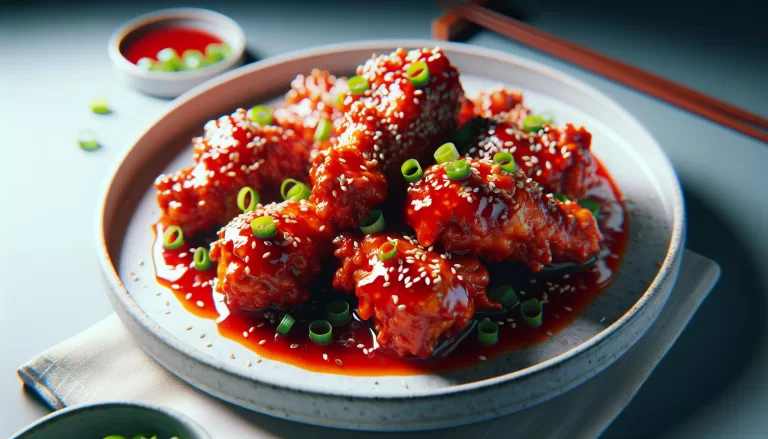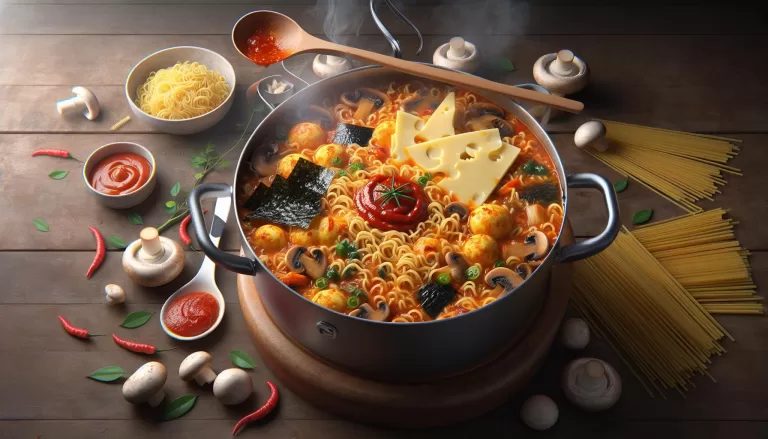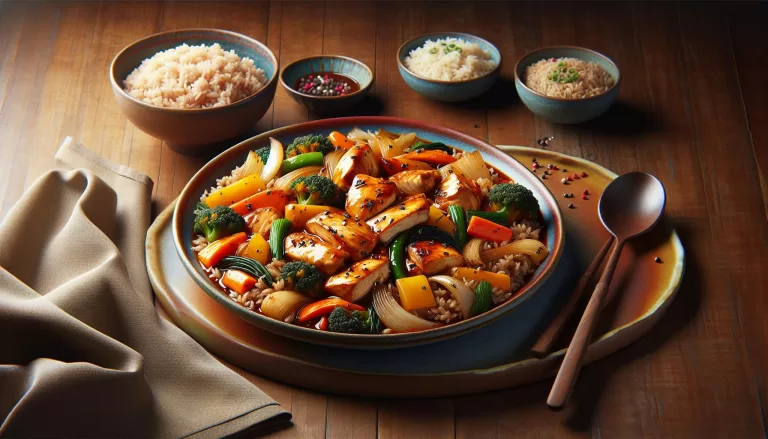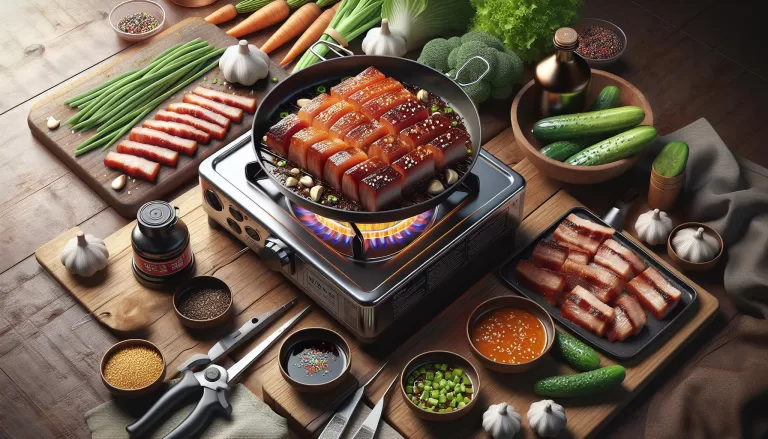Easy Homemade Myulchi Bokkeum Recipe for Authentic Korean Dining Experience

What is Myulchi Bokkeum?
You may ask, “What is Myulchi Bokkeum?” Well, it’s a delightful dish straight out of the heart of Korean culinary tradition. Serving up a blend of sweet, salty, and spicy flavors, Myulchi Bokkeum showcases the versatility of its humble main ingredient – anchovies.
Think anchovies are only good for pizza toppings? Then Myulchi Bokkeum will change your perception. In Korean, ‘Myulchi’ means anchovies and ‘Bokkeum’ refers to anything stir-fried. Paired together, what you get is a dish that harmonises the intense, flavorful anchovies with a sweet and spicy glaze.
The beauty of Myulchi Bokkeum is its simplicity. It’s a hassle-free dish that doesn’t require a laundry list of ingredients or extensive cooking skills. There is no long marination, no hours of simmering. Right from prepping to serving, it’s a quick and easy affair. And that’s what makes it perfect for everyday meals or unexpected guests.
Fun fact: Myulchi Bokkeum gives anchovies the spotlight they always deserved. While anchovies are often used in Korean cooking for preparing stock, Myulchi Bokkeum lets them shine as the star ingredient.
But it’s not just the taste that will win you over. This classic Korean stir-fry is packed with nutrients, offering a substantial amount of protein and Omega-3 fatty acids. In addition, anchovies are rich in calcium, magnesium and other important minerals that your body needs.
Key Ingredients for Myulchi Bokkeum

Unleashing the robust flavor of Myulchi Bokkeum starts with gathering the right ingredients.
- Dried Anchovies: Essential for this dish – you can’t skip it. Ensure they’re the small, dried variety. This star component brings a unique, intense flavor. It’s a tasty way to get your protein, Omega-3 fatty acids, and essential minerals all in one.
- Garlic and Ginger: These give an added punch with their aromatic attributes. They’re the secret behind the spiciness that Myulchi Bokkeum is known for.
- Soy Sauce and Sugar: These two balance the dish’s flavor profile with their sweet and salty tones. It’s crucial to ensure harmony when cooking this traditional Korean dish.
- Gochujang Paste: Another vital ingredient, gochujang paste, imparts a gentle heat, creating a nice zing that’s not too hot to the palate. This Korean red pepper paste further enhances the dish’s authenticity.
- Sesame Seeds and Green Onions: These are used as garnish, but don’t underestimate their importance. They add a crunchy, fresh texture that complements the overall flavor.
As you gather these ingredients, feel free to experiment. For example, using honey instead of sugar can add a richer sweetness to your Myulchi Bokkeum. If you can’t source gochujang paste, select a milder chili paste as a substitute.
The nutritional value of this dish varies depending on your ingredients. On average, a serving contains:
| Nutrient | Amount |
|---|---|
| Calories | 250 |
| Protein | 20g |
| Fats | 8g |
| Carbs | 15g |
Remember, the point is to savor, explore, and enjoy the process. After all, Korean cuisine is about experiencing a symphony of taste in every bite. Let’s move on to how you can prepare your own flavorful Myulchi Bokkeum.
Step-by-Step Guide to Making Myulchi Bokkeum

We’re diving straight into the heart of this culinary adventure. So, grab your apron and let’s get cooking our homemade Myulchi Bokkeum!
Your first task is preparing your key ingredient – dried anchovies. You’ll need about 2 cups. Ensure they’re nicely cleaned and gutted.
Next, we turn to the potent combo of garlic and ginger. For this recipe, you’ll need about 2 cloves of garlic and a teaspoon of minced ginger. But don’t be afraid to tweak these amounts! If you’re a fan of either, feel free to add more.
On to the heart and soul of this dish – the sauce. Combine 2 tablespoons each of soy sauce and sugar in a bowl. Add in a tablespoon of the spicy gochujang paste.
Make sure you’ve got a well-heated pan ready. Start by gently frying your garlic and ginger. Once they’re turning golden, add your anchovies. Stir fry them until they turn slightly crispy.
The next step is your sauce. Pour it over the anchovies and stir well so everything is splendidly coated. Your goal here is to make sure those anchovies are soaking up all that flavorful magic.
Lastly, sprinkle some sesame seeds and chop up some green onions. Toss these into your pan and give your dish that final stir. Remember, the aim here isn’t to cook these final ingredients. They’re included for a fresh, crunchy contrasts to those sizzling anchovies.
Take note of this break down for your convenience:
| Ingredients | Quantity |
|---|---|
| Dried anchovies | 2 cups |
| Garlic cloves | 2 |
| Minced ginger | 1 tsp |
| Soy sauce | 2 tbsp |
| Sugar | 2 tbsp |
| Gochujang paste | 1 tbsp |
| Sesame seeds | To taste |
| Green onions | To taste |
Here’s a bonus tip for you: If you have a sweet tooth or if you’re looking for a unique spin, substitute half the sugar with some honey. This gives a delightful sweet-and-salty contrast in your Myulchi Bokkeum.
Tips for Perfecting Your Myulchi Bokkeum

There’s no denying it. To truly master the art of cooking, and specifically Korean cuisine, one needs a dash of patience, a spoon of creativity, and a handful of handy tips. Let’s delve into some nuggets of wisdom that’ll turn your homemade Myulchi Bokkeum into a masterpiece.
First things first, the quality of dried anchovies is a game-changer. It’s relatively easy to find them in an Asian grocery, or even online. But remember, aim for high-quality ones. Often, they’re a bit pricier but believe me, they’re worth every penny.
Let’s talk about the sauce. It’s like the heart of Myulchi Bokkeum that pulses with flavors. If you love your dish extra spicy, don’t hesitate to add a touch more gochujang paste. On the other hand, if sweet and salty is your thing, consider replacing half the sugar with honey. It’s a little tweak, yet it brings a uniquely rich, velvety sweetness that balances the saltiness of the anchovies.
Here comes a tip about the cooking process. When you’re stir-frying the anchovies, keep the fire at medium. Don’t rush the process. Patience is key here, stir-fry until the anchovies get crispy. Add the sauce and toss them around until all the anchovies are evenly coated.
Lastly, let’s not forget the stars of the finishing touch: sesame seeds and green onions. They add that extra crunch and freshness that take your Myulchi Bokkeum to another level. Don’t be shy to sprinkle a generous amount of roasted sesame seeds, and as for green onions, thinly slice them for that vibrant punch of freshness.
While this traditional dish is easy to whip up, knowing these tips will surely elevate your Myulchi Bokkeum. But remember, the beauty of cooking lies in experimenting. Feel free to personalize this dish to your own taste buds.
Serving and Enjoying Myulchi Bokkeum

Now that you’ve perfected your Myulchi Bokkeum, it’s time to create the ideal serving scenario. This dish is best enjoyed hot and with seamless company. Keep it satisfyingly simple by pairing it with a bowl of freshly cooked steamed rice. The contrast between the humble, soft flavor of rice and the robust taste of stir-fried anchovy provides a harmonious dining experience.
For a more comprehensive meal, consider incorporating additional Korean staples. Kimchi and pickled radishes wonderfully accent Myulchi Bokkeum with their tang, while a bowl of comforting Doenjang Jjigae (soybean paste stew) adds further dimension to your Korean feast. Reinvent Myulchi Bokkeum as a banchan – a side dish – in a traditional Korean spread, asserting your culinary creativity.
Creating a meal isn’t solely about the food though; it’s also about the environment. A laidback atmosphere is ideal for indulging in comfort food. Set the table with traditional Korean dining ware to truly set the scene for your authentic Korean feast. An inviting ambiance will truly make your Myulchi Bokkeum experience memorable.
Your Health Matters Too
If you’re keeping score on the nutritional front, Myulchi Bokkeum won’t disappoint. This dish is a lightweight warrior, packed with protein and low in fat. For all its flavor, it’s surprisingly low in calories.
| Calories | Protein | Carbs | Fat |
|---|---|---|---|
| 52 | 5g | 5g | 1g |
Calories from fat are, on average, just 9 per serving, providing you with a hearty, guilt-free meal. The protein content helps to keep you sated, while the carbs give the energy that you need to power through your day.
Unconventionally, this dish helps you get in your dose of daily nutrients, with a serving of Myulchi Bokkeum providing Calcium, Iron, and Potassium. The nutrition makeup of this dish stands as further proof of its well-rounded nature – a healthful addition to your meal plan.
Conclusion
So you’ve mastered the art of making homemade Myulchi Bokkeum. You now know the perfect pairings to elevate your meal and the key elements for creating an authentic Korean dining experience. Remember, this stir-fried anchovy dish isn’t just a delight to your taste buds, it’s also a nutritional powerhouse. Packed with protein and essential nutrients like Calcium, Iron, and Potassium, it’s a healthy choice that’s low in calories and fat. As a banchan, it’s a versatile addition to your culinary repertoire. So go ahead and relish your homemade Myulchi Bokkeum, knowing you’re enjoying a flavorful, nutritious, and culturally rich dish.





